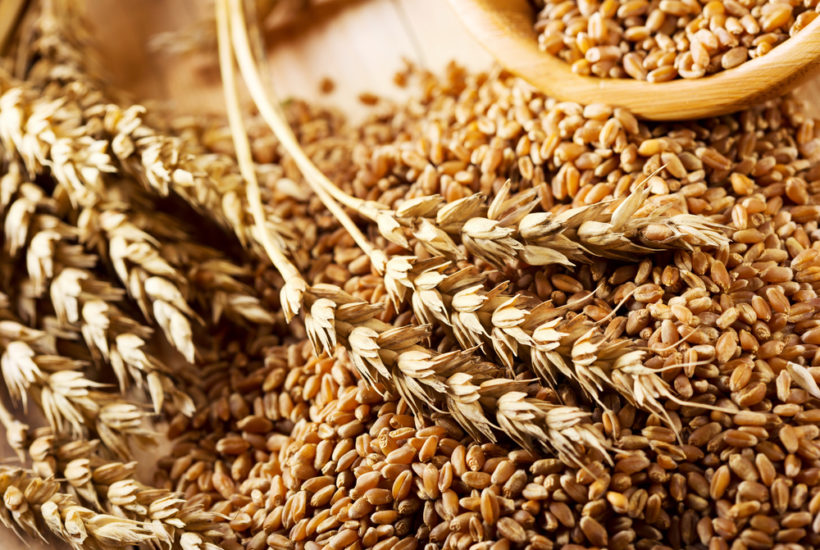Featured
Wheat markets closed lower amid better weather
The weather in the U.S. and around the world is getting better and wheat harvest should get underway soon.

Wheat
Wheat markets were lower as the weather here in the US and around the world got better. The weather is drier for harvesting in the southern Great Plains and the harvest is fully underway. High yields are being reported for the HRW crop and this is as it should be as the region saw a lot of rain during the growing season. It is finally turning drier in the Midwest so the Winter Wheat harvest should get underway soon. Yields might not be so impressive in this area due to the extreme weather seen over the Winter that probably caused Winterkill. In addition, there are ideas that the SRW crop will show disease due to all of the rain until now. Protein levels for both HRW and SRW crops should be lower than normal due to the rains.
Meanwhile, rains have improved in the northern Great Plains and into Canada and growing conditions for the Spring Wheat crops are improving. Additional rains were forecast for Canada over the weekend. Conditions are also reported to be improving in Spring Wheat areas in Russia as temperatures are expected to moderate and some showers are expected. It is still hot and dry near the Black Sea so crops in these areas of Russia and Ukraine are being hurt. It is harvest time for Winter crops in these areas as well. Conditions are reported to be generally good in Europe. USDA released its monthly supply and demand updates early last week and showed the potential for more feed demand in the US. This comes as a result of the problems getting the US Corn crop planted that will keep Corn prices relatively elevated and the expected abundance of low protein Wheat in the Great Plains that will be very good for feed but not so good for milling.
Corn
Corn and Oats both closed lower last week. The highs in Corn were made in response to the monthly USDA supply and demand updates. USDA trimmed planted area by three million acres and also cut yields by ten bushels per acre to 166 bushels per acre. The estimates were more or less expected by the trade, and further adjustments are expected over time. USDA is likely to show less planted area over time and there is also a potential for yields to be cut further. The crop is planted for all intents and purposes and much of the crop has been planted in the last few weeks and is very short and very far behind normal progress. There is a chance that cold weather this Fall will catch much of the crop before it is mature and even more bushels could be lost. There is a long way to go before that can be a consideration, and the weather outlook for the coming week seems to be improved.
There will be showers but overall the forecast seems drier. It looks like the Midwest will turn warmer, so overall growing conditions should be better. This will be great for the crops as there is plenty of soil moisture and the crops should really start to develop with some sun and warmer temperatures. Futures were unable to sustain the rally for that reason and there are ideas that the rally might be over for now until more is known about the size of the actual crop. Discovering the potential crop size is likely to take quite some time as USDA will need to find the actual acreage and that might not come until producers certify the area for various government programs in the next couple of months. The market will stay very close to all weather forecasts as the weather will need to be just about perfect from here on out to promote the best yield potential. More extreme weather will cost even more yield and force smaller crops, something the market will react to in a big way. Either way, a move close to or above $5.00 per bushel for new crop Corn futures seems very possible.
Soybeans and soybean meal
Soybeans were higher and Soybean Meal was lower last week. The weather is a feature in this market as it has been for Corn. The planting of Soybeans has been just as difficult as planting has been for Corn. There is still a significant part of the crop to be planted and producers will not get done in the USDA data on Monday. Producers still have time to get the Soybeans in the ground as most indicate they will still plant this week and possibly into the Independence Day holiday in the US on July 4th. That should be it, but it could be enough time to get the crop planted depending on the weather. There will undoubtedly be yield loss and USDA will start to calculate the lost crop potential in its monthly updates next month. It seems unlikely now that lost Corn area will get planted to
Soybeans as USDA is allowing cover crops to be harvested early in response to the lost Corn production. The trade is also worried about a permanent loss of demand from China due in part to the Swine Flu there and in other parts of Southeast Asia and the trade war with China. This is also happening and the Brazilian producer has been the beneficiary on increased demand from China due to the trade wars. The US has been selling Soybeans almost everywhere else as US prices have been competitive, but the biggest buyer in the world will not buy from the US due to the increased trade tensions. Neither side seems ready to make a deal right now although Trump and Xi will meet this week at the G-20 meetings to try to get talks going again. The Brazilian Real has firmed again in the last week. This will increase Brazil prices and will help the US remain competitive in world markets.
Rice
Rice was lower last week as the rally collapsed. The export sales report was weaker and USDA did not show any big losses in its monthly supply and demand updates early last week. Funds and other speculators were the best sellers. Nearby futures got close to some important support near $11.00 per hundredweight before finding much buying interest. That point will continue to serve as important support this week. The weather seems to be better in Rice country. There was less rain reported in the south and into Mississippi and crop development near the Gulf Coast is called good. The better crop development has created some selling interest for the last of the old crop Rice in producer storage. Some of the producers in Mississippi, Arkansas, and southern Missouri will stop trying to plant Rice and will try to plant Soybeans instead. There can be little doubt now that the total planted area will be somewhat reduced, especially in Mississippi and Arkansas.
Just how much the planted area will be reduced seems to be a guess at this point. California is reporting good conditions now with hot and drier weather. The crop was planted a little late and the crop condition ratings have not been as strong as is normally seen in the state. The crop there is probably about a week behind normal development. Crop development seems to be generally good in the main Rice Belt and crops in southern areas are now in flood. This has helped ease some quality concerns for producers. World prices remain stable to firm so there is a good chance for more US sales to the west as South America does not appear to be competitive this year. Mostly stable prices are reported in Asia. Indian price trends in the near future are a guess as the monsoon has been late to arrive. There are forecasts for reduced rains from the monsoon this year implying lower yields and lower overall production potential. That would be great for the world market as India usually dumps it surplus out to the world at very low prices that are subsidized by the government.
Palm oil and vegetable oils
Palm Oil was about unchanged in narrow range trading last week. The market hopes for better demand but this demand has not really shown up yet as the private sources reported that month on month export demand was slightly lower than last month. The market also talks about big supplies and supplies appear good for the projected demand. Canola was a little lower for the week in range trading as rains were seen in the Prairies and more was in the forecast.
A drought had been developing in the Canadian Prairies. It has been very dry there and the crops in the region really need a drink. They are starting to get that drink now. There were chances for some precipitation over the weekend. There are hopes that Chinese demand can return as well. Soybean Oil was firm due to the rally in Crude Oil amid renewed and increased tensions with Iran. The move higher in Crude Oil and products implies more demand for biofuels. Chicago Soybeans futures are also rallying on the potential for less production. Trends are up in Soybeans and trends could turn up in Soybean Oil in sympathy.
Cotton
Cotton was sharply lower for the week and traded to the lowest levels since 2016 as traders become more concerned about planting progress and crop development of this crop. The crop progress has been very close to the five-year average and crop conditions are called mixed. Trends remain down on the daily and weekly charts. The weather has been bad, especially in the Texas Panhandle, where there are concerns that it has been too wet and cool for the crop to be developed well. That should be changing now as it has been warmer and drier in the last couple of weeks. The Delta has also been wet and some rains have been seen in the Southeast over the last few weeks. Cotton planting fell behind the five-year average a couple of weeks ago, but farmers were able to make up for lost time last week and the data today should show good progress again.
Demand is a problem for traders due mostly to moves made in Washington. Cotton is already experiencing lost business potential with China and Turkey and could get hurt if Vietnam is targeted for tariffs later on. China and Turkey both canceled purchases for the current crop year in the export sales report last week although both were reported as buyers for the new crop. Also pressuring the market are forecasts for big production around the world. USDA sees no shortage of Cotton anywhere in the coming year. However, the Indian monsoon is off to a slow start and production potential could be hurt there and in Pakistan. Monsoon rains have started to move into central and southern parts of the country but these rains are arriving a couple of weeks late. Below normal rains are now in the forecast for June and longer range forecasts call for a drier September as well as the monsoon should be generally weaker than normal.
Frozen concentrated orange juice and citrus
FCOJ was a little lower again last week as the weather in Florida remained tranquil. Futures a[pear poised to move back to or below 90.00 seen earlier in the year. Speculators have been buying in anticipation of the hurricane season, but there are no storms on the horizon this early in the season. They are selling some of these positions now and producers have also been looking to sell as the orange crop in Florida looks to be big. The hurricane season started on June 1, but so far the state has seen only an increase in showers and storms that have been beneficial for crops. Trends are sideways to down on the daily charts and weekly charts as the market looks at a big orange crop and weak demand for FCOJ.
USDA production estimates are above 70 million boxes and represent a remarkable recovery from the greening disease and the small crops of just a couple of years ago. Inventories in Florida are still 17 percent above a year ago. That means that there should be no shortage of oranges available to the market to make FCOJ. The increase is coming from less demand along with the increased domestic production. Fruit for the next crop is developing and are as big as golf balls. Crop conditions are called good. Irrigation is being used a few times a week to help protect crop condition. Mostly good conditions are reported in Brazil as the harvest there is active.
Coffee
Futures were lower early in the week, then rebounded to close higher after testing support areas near the recent lows in both New York and London. The US Dollar moved sharply lower in the second half of the week and caused a firm Real. The market will look to add to gains this week and could confirm an important low in prices if new moves higher can be sustained. A strong export pace from Brazil remains a problem for the bulls. Brazil exported over 3.0 million bags of Coffee again last month. The Brazil harvest is moving along at a slow pace and producers are trying to store the crop due to the current low prices. Reports indicate that the yields are not really strong and that the quality of the crop is poor due to extreme weather seen early in the growing season.
Vietnam is also reporting lower yields for the current crop as the weather was not good for flowering earlier in the year. There have been some hot and dry spells that have hurt yield and quality for these crops as well, but showers are reported in the Central Highlands now and ideas are that conditions and production potential have improved. Buyers are now more actively pursuing other origins, especially for certified or higher end coffees. Roasters were scaling down buyers on the extended down move and now have more than ample supplies in-house or on the way. Brazil had a big production year for the current crop, but the next crop should be less as it is an off year for production.
Sugar
Futures closed lower, with London the leader on the way down. Reports from India indicate that the country still has a large surplus of White Sugar that probably must be exported. India has always been willing to dump agricultural goods such as Rice and Sugar at below cost prices, so the market began to anticipate improved sales from mills and exporters there. There are concerns that the Indian monsoon will not be strong this year and that Sugarcane production could be hurt. It is hot and dry there, so far, but there are signs that the monsoon is ready to develop. Even so, there are now a lot of private forecasts that June rains in both India and Pakistan will be below average. The government weather services there are looking for a normal monsoon, but many private forecasters expect less rain and warmer temperatures than normal.
The Real was firm late in the week against the US Dollar and made new highs for its recovery move. The move higher in the Real helped support world prices, as did more reports that Brazilian processors prefer to make Ethanol for the domestic market rather than Sugar for the export market. Processing of Sugarcane in Brazil is faster now after a very slow start as with the harvest in full swing. The fundamentals still suggest big supplies, and the weather in Brazil and India has improved to support some of the big production ideas. Demand seems to be average and routine. Very good conditions are reported in Thailand. Demand for Sugar has been average, and demand for ethanol is reported to be increasing.
Cocoa
Futures closed mixed, with New York a little higher and London a little lower. The main headline for Cocoa continues to be the reports of production losses in Ghana. Ghana Cocoa authorities noted disease problems in its crop and said that mid-crop production could be hurt. The disease could hurt the mid-crop and probably will affect the next main crop that will be harvested at the end of the year. They say that about 50,000 tons were lost in the mid-crop. The mid-crop harvest is winding down in West Africa and reports are generally positive, although some Nigerian producers have complained that the weather is not giving them the best conditions for top yields. Ivory Coast arrivals are strong as are the exports. The weekly arrivals pace is about 15 percent higher than a year ago and is holding this level.
Demand appears strong and the market saw stronger than expected grind data when the quarterly grind is released in the EU, North America, and Asia in the last reports and ideas are that this strong demand is continuing. Growing conditions are generally good in West Africa. Periods of showers and cooler temperatures were beneficial, and many in Ivory Coast expect a very good mid-crop harvest. Cameroon and Nigeria are reporting less production and prices there are reported strong. Conditions appear generally good in East Africa and Asia, but East Africa has been a little dry as has Malaysia.
(Featured image by DepositPhotos)
—
DISCLAIMER: This article expresses my own ideas and opinions. Any information I have shared are from sources that I believe to be reliable and accurate. I did not receive any financial compensation for writing this post, nor do I own any shares in any company I’ve mentioned. I encourage any reader to do their own diligent research first before making any investment decisions.

-

 Crypto2 days ago
Crypto2 days agoBitcoin Surges Toward $110K Amid Trade News and Solana ETF Boost
-

 Fintech1 week ago
Fintech1 week agoMuzinich and Nao Partner to Open Private Credit Fund to Retail Investors
-

 Crypto5 days ago
Crypto5 days agoBitcoin Traders on DEXs Brace for Downturn Despite Price Rally
-

 Business2 weeks ago
Business2 weeks agoDebt-Fueled Markets, Zombie Corporations, and the Coming Reckoning
























